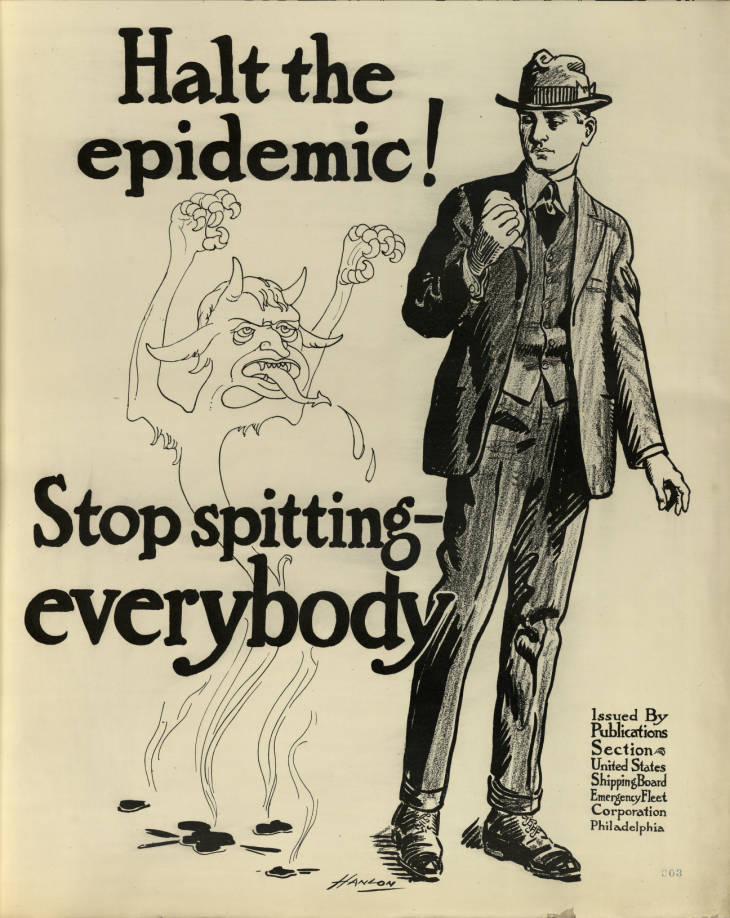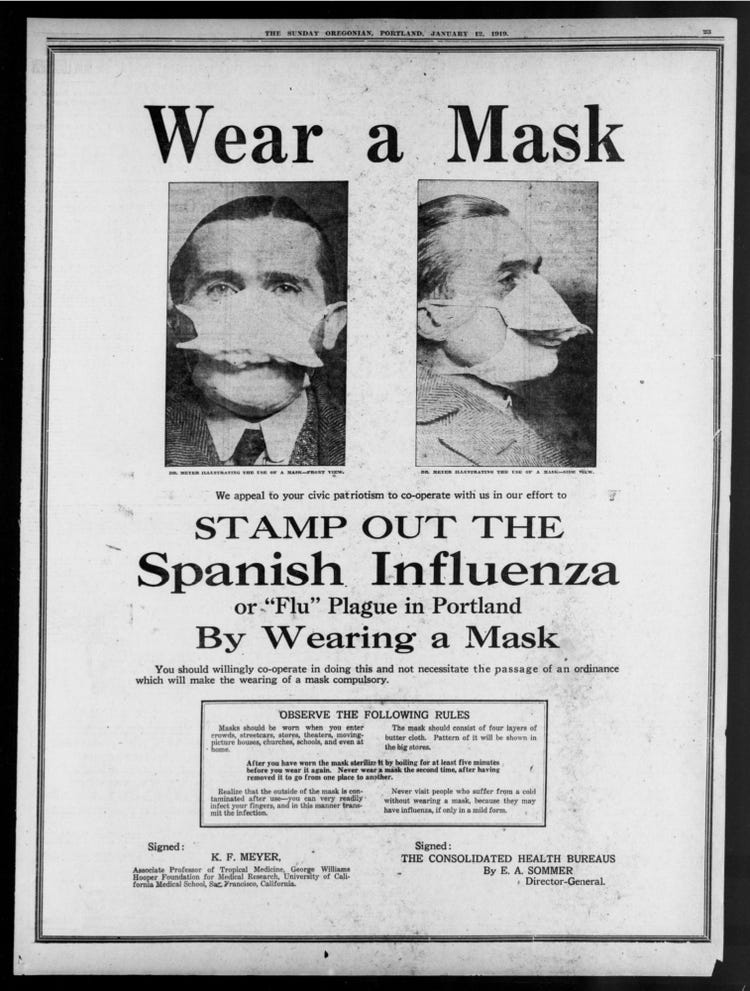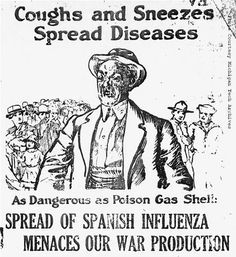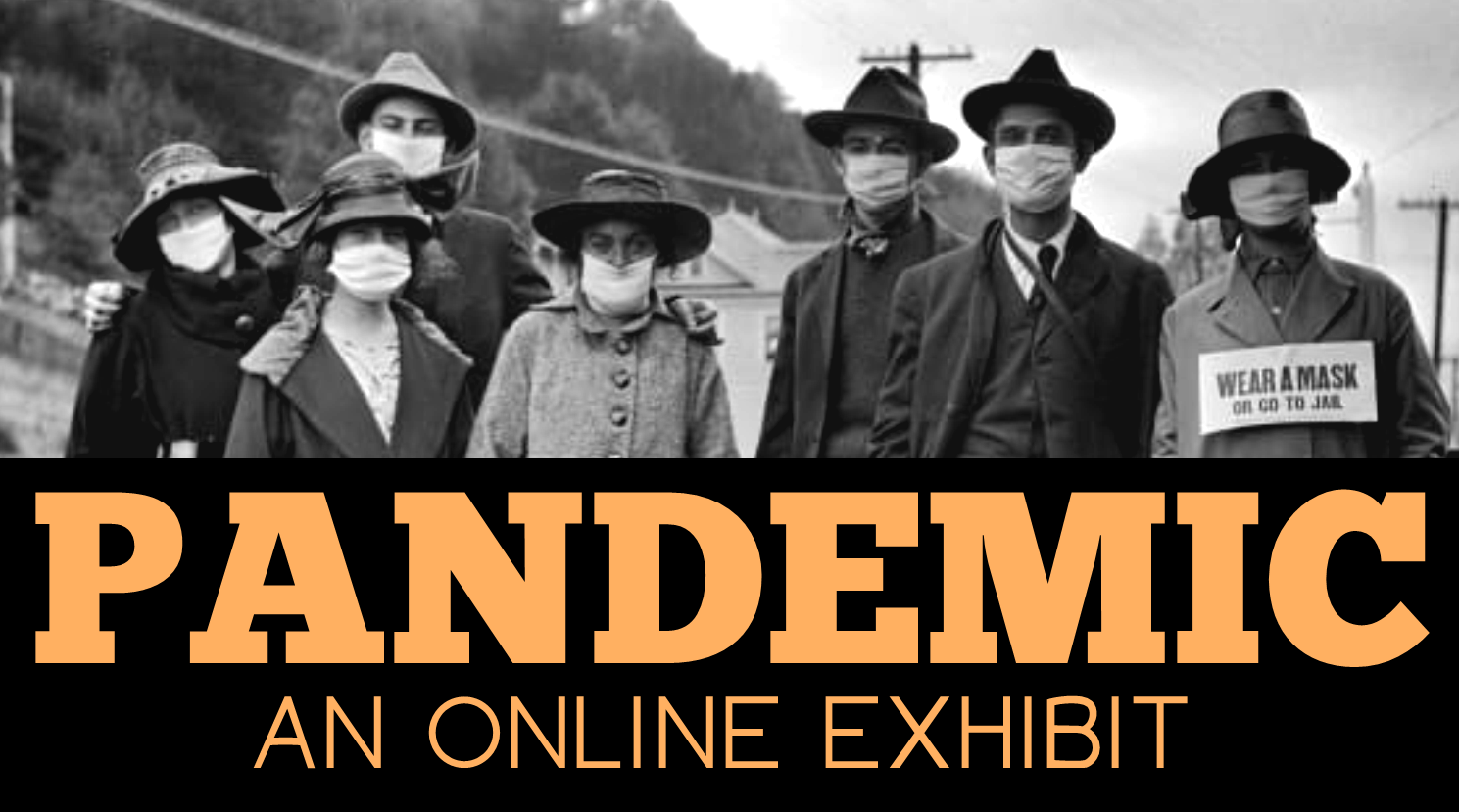
There is no question that 2020 has been a challenge. All of us have had our lives touched by the COVID-19 pandemic. The goal of this online exhibit is to remind us that pandemics are something with a long historical precedent, that they can be horrible and dramatically alter life, but that, eventually life continues.
In the meantime, the best thing we can all do is wear a mask, practice social distancing, and observe all guidelines in regards to the pandemic. Together, like those in the past, we can see it through.
Historic Pandemics Before 1500
Pandemics have a long history. In fact, they have been occurring for as long as mankind has been around. While there are many historic pandemics before the year 1500, here are two famous ones caused by the same bacteria: Yersinia Pestis.
Learn about the Plague of Justinian and the Black Death by clicking the tabs below.
The Plague of Justinian
When: 531-549 C.E.
What: The bacteria Yersinia Pestis
Where: The Mediterranean Basin, Europe, Near East
Death Rate: 1 million people
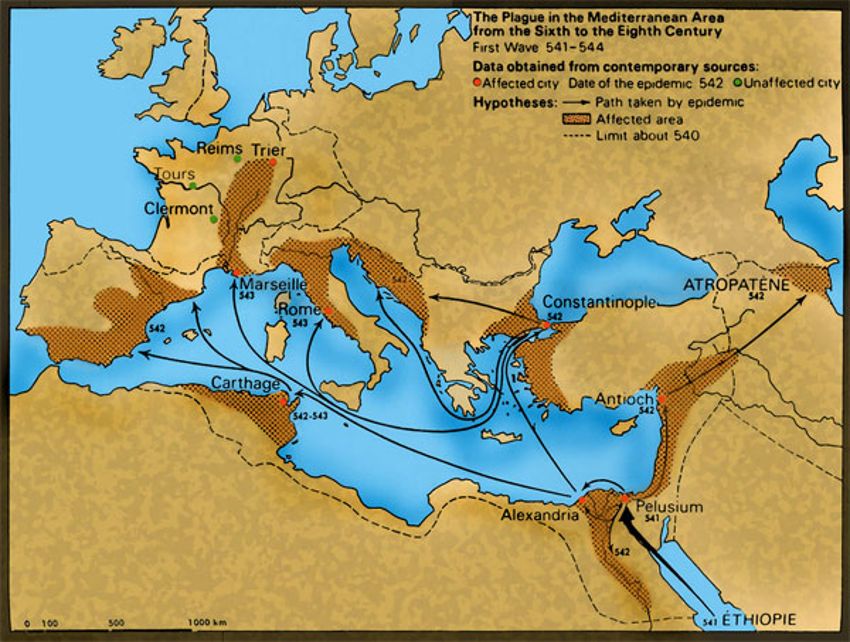
“But for this calamity it is quite impossible either to express in words or to conceive in thought any explanation, except indeed to refer it to God. For it did not come in a part of the world nor upon certain men, nor did it confine itself to any season of the year, so that from such circumstances it might be possible to find subtle explanations of a cause, but it embraced the entire world, and blighted the lives of all men, though differing from one another in the most marked degree, respecting neither sex nor age.” -Procopius, c. 553.
The Plague of Justinian received its name from the Roman Emperor Justinian (r. 527-565) who is said to have contracted the disease in Constantinople, the capital of the Roman Empire, and recovered. A fifth of the population of Constantinople died of the disease, and historical estimates think that 1 million people died over the 18 years that the plague ravaged the Mediterranian. Long before there was any knowledge of germ theory, people undertook self-isolation and distanced themselves from their neighbors, which proved to be effective in slowing the spread of the disease.
The Black Death
When: 1346-1353
What: The bacteria Yersinia Pestis
Where: Europe and the Near East, Mediterranian Basin, North Africa, Asia
Death rate: Anywhere from 75,000,000 million to 200,000,000 million people
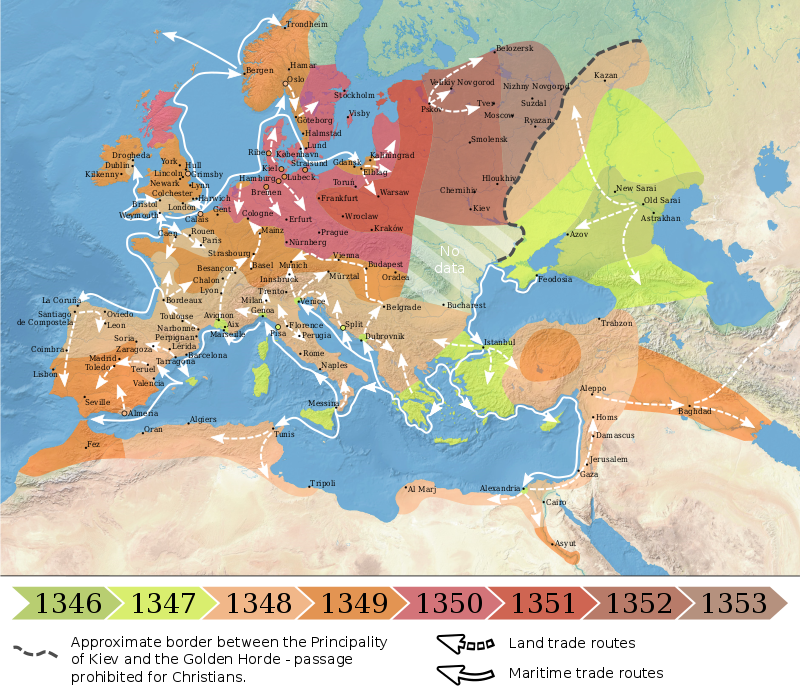
“Father abandoned child, wife husband, one brother another; for this illness seemed to strike through the breath and sight. And so they died. And none could be found to bury the dead for money or friendship. Members of a household brought their dead to a ditch as best they could, without priest, without divine offices … great pits were dug and piled deep with the multitude of dead. And they died by the hundreds both day and night … And as soon as those ditches were filled more were dug … And I, Agnolo di Tura … buried my five children with my own hands. And there were also those who were so sparsely covered with earth that the dogs dragged them forth and devoured many bodies throughout the city. There was no one who wept for any death, for all awaited death. And so many died that all believed it was the end of the world.” -Italian Chronicler Agnolo di Tura, in Siena, May 1348
Like the Plague of Justinian, the Black Death was the result of the bacteria Yersinia Pestis, which spread through fleas in cities and towns that were filled with animals and unsanitary living conditions.
It is hard to imagine the sheer devastation that was the Black Death. It is believed that the Black Death killed 30% to 60% of the population of Europe. Many scholars believe that, as a result of this massive death, society restructured itself, allowing for the rise of the time period that we refer to as the Renaissance.
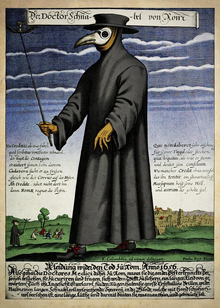
Did you know: While we often think of the beaked plague doctor in connection with the Black Death, there is no evidence that doctors wore such a costume. The beaked plague doctor as we know it probably originated in 17th century Italy. It was believed to protect the wearer from disease, which was believed to be passed through miasmas, or bad airs. It covered the body, leaving no skin exposed. Likewise, the beak contained fragrant herbs, to prevent the wearer from inhaling “bad air.”
Pandemics in Early America
Pandemics ravaged the Americas through the period of colonization and continued throughout the colonial period, through and past the American Revolution.
Smallpox
When: Throughout human history, until it’s irradiation in 1980. Most noteworthy pandemic: 1492-1674
What: the viruses Variola major and Variola minor
Where: Everywhere
Death rate: Uncounted Millions
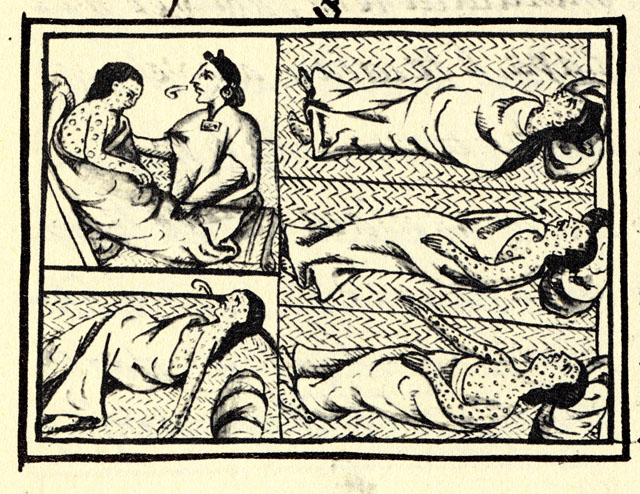
“. . . [The disease] brought great desolation: a great many died of it. They could no longer walk about, but lay in their dwellings and sleeping places, no longer able to move or stir. They were unable to change position, to stretch out on their sides or face down, or raise their heads. And when they made a motion, they called out loudly. The pustules that covered people caused great desolation; very many people died of them, and many just starved to death; starvation reigned, and no one took care of others any longer. On some people, the pustules appeared only far apart, and they did not suffer greatly, nor did many of them die of it. But many people’s faces were spoiled by it, their faces were made rough. Some lost an eye or were blinded.” -Bernardino de Sahagun, The Florentine Codex, Mexico, 16th Century
Smallpox was long part of life in the Old World, and evidence of smallpox has even been found on Egyptian mummies. While outbreaks had occurred, there was built herd immunity to the disease over the centuries.
When Europeans discovered the Americas, the disease plowed mercilessly through indigenous populations, often reaching them before the arrival of Europeans. It is believed that smallpox reached the Americas in 1520 with Spanish conquistador Panfilo de Narvaez in Veracruz, in modern day Mexico. The disease reached the Tenochtitlan (capital city of the people commonly known as Aztec, now Mexico City), then moved throughout the Americas. It is believed that as many as 90% of the indigenous population succumbed to smallpox and other Old World diseases, of which they had no immunity.
Smallpox continued to ravage the Americas in plagues until its eradication through inoculation in 1980. Most famously, George Washington demanded that all troops in the Continental Army be inoculated for smallpox to protect his troops from a smallpox epidemic that sprung up during the American Revolution.
Yellow Fever
When: Philadelphia, 1793
What: the Yellow Fever Virus spread by Mosquitoes
Where: Philadelphia, Pennsylvania
Death rate: 5,000 people between August and November, in a city of 50,000
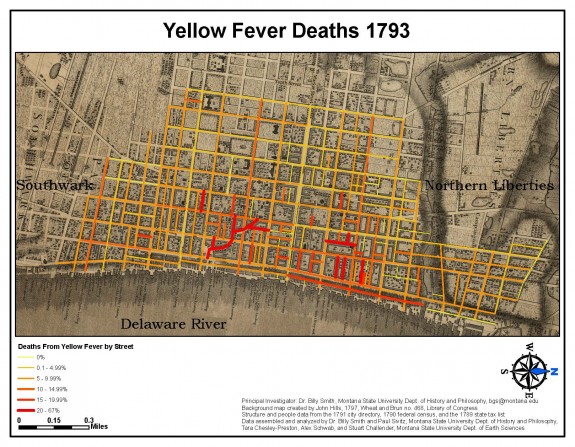
“Those who ventured abroad, had handkerchiefs or sponges impregnated with vinegar of camphor at their noses, or smelling-bottles full of the thieves’ vinegar. Others carried pieces of tarred rope in their hands or pockets, or camphor bags tied round their necks…. People hastily shifted their course at the sight of a hearse coming towards them. Many never walked on the footpath, but went into the middle of the streets, to avoid being infected in passing by houses wherein people had died. Acquaintances and friends avoided each other in the streets, and only signified their regard by a cold nod. The old custom of shaking hands fell in such general disuse, that many shrunk back with affright at even the offer of a hand. A person with crape [mourning crepe], or any appearance of mourning, was shunned like a viper.” -Mathew Carey, 1793
Yellow Fever, which was spread by mosquitoes, probably arrived in Philadelphia on the British ship Hankey, which was arriving from a colony off of modern day Guinea-Bissau in western Africa. The ship seems to have been spreading the disease in every port it landed in.
The disease was noted by prominent Philadelphia physician Benjamin Rush, who noticed the spread of the disease as similar to a previous epidemic of 1763. Temporary hospitals were constructed throughout the city, as the outbreak ravaged the city. The pandemic ceased in October, as frost killed the mosquitos who had been spreading the disease. The mosquitoes’ connection to the spread of yellow fever was not known until the end of the nineteenth century
Pandemics in the Modern World
The Spanish Flu of 1918
When: 1918-1920
What: Various strains of H1N1 Influenza A Virus
Where: Worldwide
Death rate: 17,000,000 million people to more than 50,000,000 million people
“About 12 o’clock I began to feel hot. I was so feverish I was afraid I would ignite the clothing. I had a cough that tore my very innards out when I could not suppress it. It was dark; I surely had pneumonia and I never was so forlorn and uncomfortable in my life. … Then I found that I was breaking into a deluge of perspiration and while I should have been more comfortable I was more miserable than ever.” -Physician Franklin Martin, 1919
Spanish Flu infected 500 million people, which was a third of the world’s population, in four waves. It was one of the deadliest pandemics in human history, though it had a death rate of only 1%. The illness was first documented in Kansas in the United States, then France, Germany, and the United Kingdom. Accounts of the disease were minimized to aid morale during the first World War. The disease became known as the Spanish Flu because Spain was a neutral party during the war and, therefore, did not censor accounts of the disease.
During the Spanish Flu Pandemic, mask wearing was government mandated, though many refused the wearing of masks, saying it was an infringement of civil liberties. As a result, the disease continued to have outbreaks throughout the country from 1918 to 1920.
Spanish Flu was the first of two pandemics which were the result of the H1N1 Influenza A Virus. The second occurred very recently: it was the Swine Flu Pandemic of 2009.
Many ads and propaganda posters were created during the Spanish Flu pandemic to encourage proper safety protocols throughout the nation. You can explore some of them by clicking through the images below.
The Late Twentieth and Early Twenty-First Century
The twentieth and twenty first century, so far, have been characterized by two large scale pandemics and several smaller epidemics. Here are some important, more modern, numbers.
AIDS/HIV
When: 1981 to the Present
What: The AIDS Virus
Where: Worldwide
Death rate: 33,000,000 Million People
SARS
When: 2002-2004
What: SARS-CoV or SARS CoV-1 Viruses
Where: Worldwide
Death rate: 770
Swine Flu
When: 2009-2010
What: Pandemic HINI/09 Virus
Where: Worldwide
Death rate: 200,000
Ebola
When: 2014-2016
What: Epidemic Ebola Virus
Where: West Africa
Death rate: 11,300
COVID-19
When: 2019-Present
What: Pandemic SARS-CoV-2 Virus
Where: Worldwide
Death rate: 673,822 and rising
We are living in historic times. If you are interesting in preserving the history of our current pandemic for future generations, here’s some things you can do.
- Keep a Plague Journal. One of the ways historians learn a lot about the past is through the writings of regular people who recorded their day in their diaries. Read our Log Blog about keeping a COVID-19 Journal here.
- You can fill out our survey about your experiences. As an organization that seeks to bring history to life, we realize we are living in historic times and want to help keep a record for future historians. You can fill out our survey about your pandemic experiences here.

